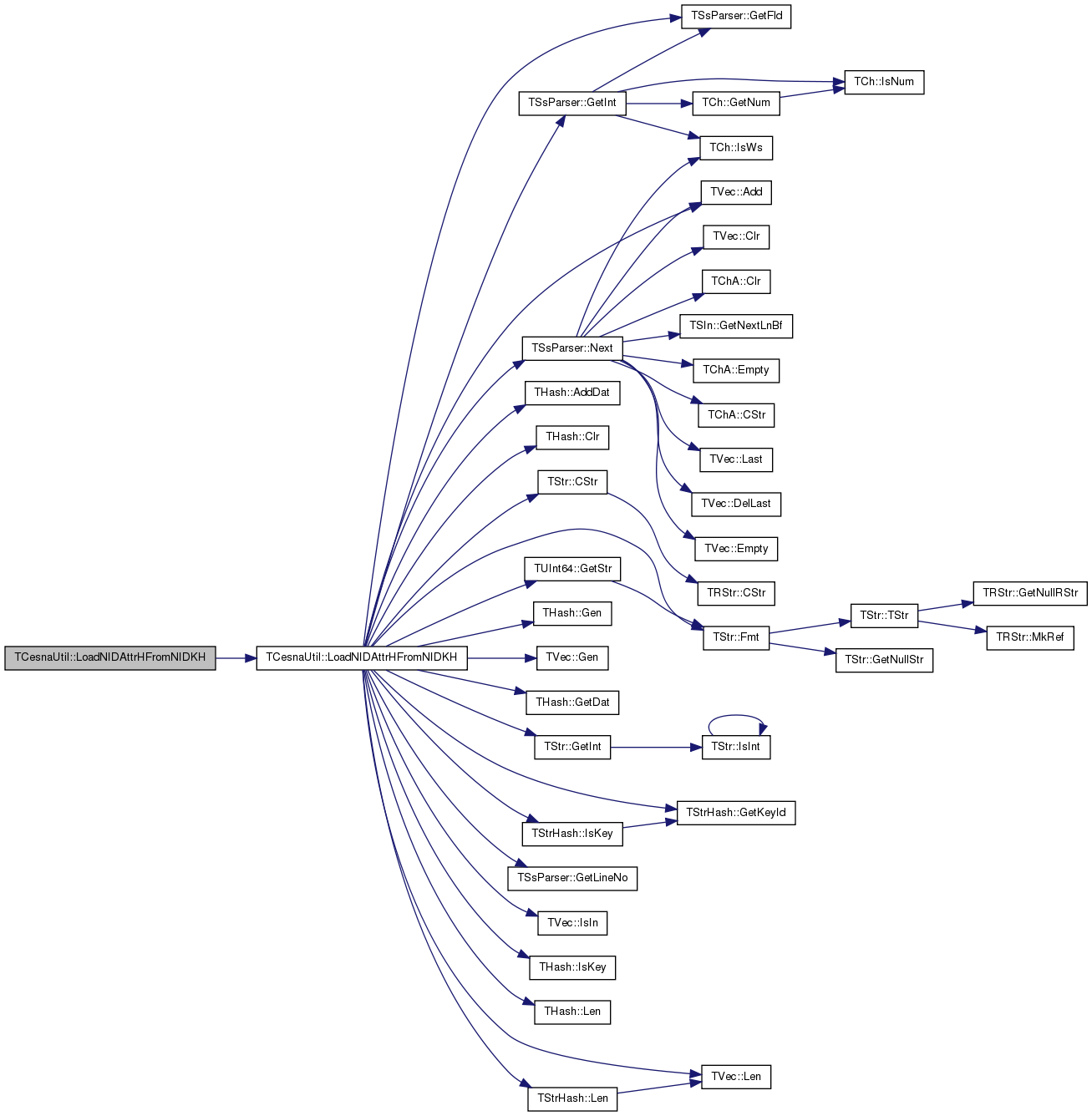|
SNAP Library 2.2, Developer Reference
2014-03-11 19:15:55
SNAP, a general purpose, high performance system for analysis and manipulation of large networks
|
|
SNAP Library 2.2, Developer Reference
2014-03-11 19:15:55
SNAP, a general purpose, high performance system for analysis and manipulation of large networks
|
#include <agmattr.h>
Static Public Member Functions | |
| template<class PGraph > | |
| static double | GetConductance (const PGraph &Graph, const TIntSet &CmtyS, const int Edges) |
| template<class PGraph > | |
| static void | GenHoldOutPairs (const PGraph &G, TVec< TIntSet > &HoldOutSet, double HOFrac, TRnd &Rnd) |
| template<class PGraph > | |
| static void | GetNbhCom (const PGraph &Graph, const int NID, TIntSet &NBCmtyS) |
| template<class PGraph > | |
| static void | GetNIdPhiV (const PGraph &G, TFltIntPrV &NIdPhiV) |
| static void | LoadNIDAttrHFromNIDKH (const TIntV &NIDV, const TStr &InFNm, THash< TInt, TIntV > &NIDAttrH, const TStrHash< TInt > &NodeNameH, const TSsFmt Sep=ssfTabSep) |
| static void | LoadNIDAttrHFromNIDKH (const TIntV &NIDV, const TStr &InFNm, THash< TInt, TIntV > &NIDAttrH) |
| static void | DumpNIDAttrHToNIDK (const TStr &FNm, const THash< TInt, TIntSet > &NIDAttrH, const TStrHash< TInt > &FeatNameH, const TStrHash< TInt > &NodeNameH) |
| static void | DumpNIDAttrHToNIDK (const TStr &FNm, const THash< TInt, TIntSet > &NIDAttrH, const TStrHash< TInt > &FeatNameH) |
| static void | DumpNIDAttrHToNIDK (const TStr &FNm, const THash< TInt, TIntSet > &NIDAttrH) |
| static void | DumpNIDAttrHToNIDK (const TStr &FNm, const THash< TInt, TIntV > &NIDAttrH, const TStrHash< TInt > &FeatNameH, const TStrHash< TInt > &NodeNameH) |
| static void | DumpNIDAttrHToNIDK (const TStr &FNm, const THash< TInt, TIntV > &NIDAttrH, const TStrHash< TInt > &FeatNameH) |
| static void | DumpNIDAttrHToNIDK (const TStr &FNm, const THash< TInt, TIntV > &NIDAttrH) |
| static int | GetAttrs (const THash< TInt, TIntV > &NIDAttrH) |
| static void | DumpNIDAttrHToMetis (const TStr &FNm, const THash< TInt, TIntV > &NIDAttrH, const TIntV &NIDV) |
| static void | FilterLowEntropy (const THash< TInt, TIntV > &OldNIDAttrH, THash< TInt, TIntV > &NewNIDAttrH, const TIntStrH &OldNameH, TIntStrH &NewNameH, const double MinFrac=0.00001, const double MaxFrac=0.95, const int MinCnt=3) |
| static void | FilterLowEntropy (const THash< TInt, TIntV > &OldNIDAttrH, THash< TInt, TIntV > &NewNIDAttrH, const double MinFrac=0.00001, const double MaxFrac=0.95, const int MinCnt=3) |
| static void TCesnaUtil::DumpNIDAttrHToMetis | ( | const TStr & | FNm, |
| const THash< TInt, TIntV > & | NIDAttrH, | ||
| const TIntV & | NIDV | ||
| ) | [inline, static] |
Definition at line 176 of file agmattr.h.
References TStr::CStr(), THash< TKey, TDat, THashFunc >::GetDat(), IAssert, THash< TKey, TDat, THashFunc >::IsKey(), and TVec< TVal, TSizeTy >::Len().
{
int AttrCnt = 0;
for (int u = 1; u < NIDV.Len(); u++) {
if (! NIDAttrH.IsKey(NIDV[u])) { continue; }
AttrCnt += NIDAttrH.GetDat(NIDV[u]).Len();
}
IAssert (NIDV[0] == -1);
FILE* F = fopen(FNm.CStr(), "wt");
fprintf(F, "%d %d\n", NIDV.Len() - 1, AttrCnt);
int TmpCnt = 0;
for (int u = 1; u < NIDV.Len(); u++) {
if (NIDAttrH.IsKey(NIDV[u])) {
for (int k = 0; k < NIDAttrH.GetDat(NIDV[u]).Len(); k++) {
if (k > 0) { fprintf(F, " "); }
fprintf(F, "%d", NIDAttrH.GetDat(NIDV[u])[k].Val + 1);
TmpCnt++;
}
}
fprintf(F, "\n");
}
fclose(F);
IAssert(AttrCnt == TmpCnt);
}
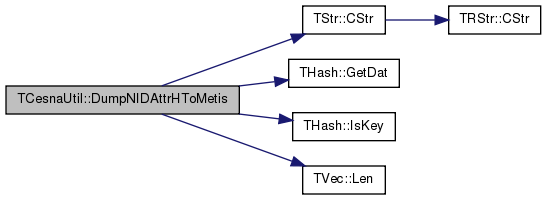
| static void TCesnaUtil::DumpNIDAttrHToNIDK | ( | const TStr & | FNm, |
| const THash< TInt, TIntSet > & | NIDAttrH, | ||
| const TStrHash< TInt > & | FeatNameH, | ||
| const TStrHash< TInt > & | NodeNameH | ||
| ) | [inline, static] |
Definition at line 124 of file agmattr.h.
References TStr::CStr(), TStr::Fmt(), THash< TKey, TDat, THashFunc >::GetKey(), TStrHash< TDat, TStringPool, THashFunc >::GetKey(), TStrHash< TDat, TStringPool, THashFunc >::IsKeyId(), and THash< TKey, TDat, THashFunc >::Len().
Referenced by DumpNIDAttrHToNIDK().
{
FILE* F = fopen(FNm.CStr(), "wt");
for (int u = 0; u < NIDAttrH.Len(); u++) {
int NID = NIDAttrH.GetKey(u);
TStr NodeName = NodeNameH.IsKeyId(NID)? NodeNameH.GetKey(NID): TStr::Fmt("%d", NID);
for (int k = 0; k < NIDAttrH[u].Len(); k++) {
int KID = NIDAttrH[u][k];
TStr FeatName = FeatNameH.IsKeyId(KID)? FeatNameH.GetKey(KID): TStr::Fmt("%d", KID);
fprintf(F,"%s\t%s\n", NodeName.CStr(), FeatName.CStr());
}
}
fclose(F);
}
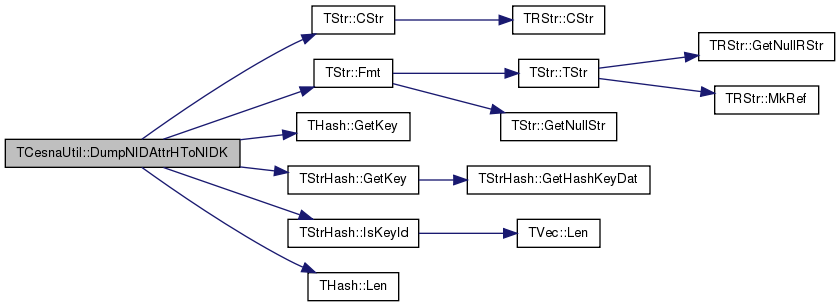

| static void TCesnaUtil::DumpNIDAttrHToNIDK | ( | const TStr & | FNm, |
| const THash< TInt, TIntSet > & | NIDAttrH, | ||
| const TStrHash< TInt > & | FeatNameH | ||
| ) | [inline, static] |
Definition at line 137 of file agmattr.h.
References DumpNIDAttrHToNIDK().
{
TStrHash<TInt> TmpH;
DumpNIDAttrHToNIDK(FNm, NIDAttrH, FeatNameH, TmpH);
}

| static void TCesnaUtil::DumpNIDAttrHToNIDK | ( | const TStr & | FNm, |
| const THash< TInt, TIntSet > & | NIDAttrH | ||
| ) | [inline, static] |
Definition at line 141 of file agmattr.h.
References DumpNIDAttrHToNIDK().
{
TStrHash<TInt> TmpH1, TmpH2;
DumpNIDAttrHToNIDK(FNm, NIDAttrH, TmpH1, TmpH2);
}

| static void TCesnaUtil::DumpNIDAttrHToNIDK | ( | const TStr & | FNm, |
| const THash< TInt, TIntV > & | NIDAttrH, | ||
| const TStrHash< TInt > & | FeatNameH, | ||
| const TStrHash< TInt > & | NodeNameH | ||
| ) | [inline, static] |
Definition at line 145 of file agmattr.h.
References TStr::CStr(), TStr::Fmt(), THash< TKey, TDat, THashFunc >::GetKey(), TStrHash< TDat, TStringPool, THashFunc >::GetKey(), TStrHash< TDat, TStringPool, THashFunc >::IsKeyId(), and THash< TKey, TDat, THashFunc >::Len().
{
FILE* F = fopen(FNm.CStr(), "wt");
for (int u = 0; u < NIDAttrH.Len(); u++) {
int NID = NIDAttrH.GetKey(u);
TStr NodeName = NodeNameH.IsKeyId(NID)? NodeNameH.GetKey(NID): TStr::Fmt("%d", NID);
for (int k = 0; k < NIDAttrH[u].Len(); k++) {
int KID = NIDAttrH[u][k];
TStr FeatName = FeatNameH.IsKeyId(KID)? FeatNameH.GetKey(KID): TStr::Fmt("%d", KID);
fprintf(F,"%s\t%s\n", NodeName.CStr(), FeatName.CStr());
}
}
fclose(F);
}
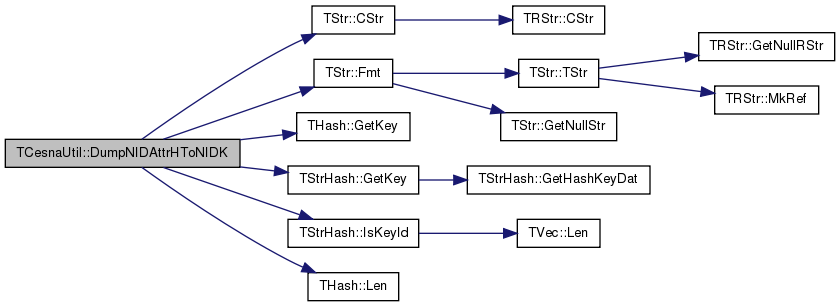
| static void TCesnaUtil::DumpNIDAttrHToNIDK | ( | const TStr & | FNm, |
| const THash< TInt, TIntV > & | NIDAttrH, | ||
| const TStrHash< TInt > & | FeatNameH | ||
| ) | [inline, static] |
Definition at line 158 of file agmattr.h.
References DumpNIDAttrHToNIDK().
{
TStrHash<TInt> TmpH;
DumpNIDAttrHToNIDK(FNm, NIDAttrH, FeatNameH, TmpH);
}

| static void TCesnaUtil::DumpNIDAttrHToNIDK | ( | const TStr & | FNm, |
| const THash< TInt, TIntV > & | NIDAttrH | ||
| ) | [inline, static] |
Definition at line 162 of file agmattr.h.
References DumpNIDAttrHToNIDK().
{
TStrHash<TInt> TmpH1, TmpH2;
DumpNIDAttrHToNIDK(FNm, NIDAttrH, TmpH1, TmpH2);
}

| static void TCesnaUtil::FilterLowEntropy | ( | const THash< TInt, TIntV > & | OldNIDAttrH, |
| THash< TInt, TIntV > & | NewNIDAttrH, | ||
| const TIntStrH & | OldNameH, | ||
| TIntStrH & | NewNameH, | ||
| const double | MinFrac = 0.00001, |
||
| const double | MaxFrac = 0.95, |
||
| const int | MinCnt = 3 |
||
| ) | [inline, static] |
Definition at line 200 of file agmattr.h.
References TVec< TVal, TSizeTy >::Add(), THash< TKey, TDat, THashFunc >::AddDat(), THash< TKey, TDat, THashFunc >::Empty(), THash< TKey, TDat, THashFunc >::Gen(), THash< TKey, TDat, THashFunc >::GetDat(), THash< TKey, TDat, THashFunc >::GetKey(), THash< TKey, TDat, THashFunc >::IsKey(), THash< TKey, TDat, THashFunc >::Len(), and THash< TKey, TDat, THashFunc >::SortByDat().
Referenced by FilterLowEntropy().
{
TIntH KIDCntH;
for (int u = 0; u < OldNIDAttrH.Len(); u++) {
for (int k = 0; k < OldNIDAttrH[u].Len(); k++) {
KIDCntH.AddDat(OldNIDAttrH[u][k])++;
}
}
KIDCntH.SortByDat(false);
TIntSet SelectedK(KIDCntH.Len());
for (int c = 0; c < KIDCntH.Len(); c++) {
double Frac = (double) KIDCntH[c].Val / (double) OldNIDAttrH.Len();
if (KIDCntH[c].Val < MinCnt) { continue; }
if (Frac > MaxFrac || Frac < MinFrac) { continue; }
SelectedK.AddKey(KIDCntH.GetKey(c));
}
printf("%d attributes selected from %d\n", SelectedK.Len(), KIDCntH.Len());
NewNIDAttrH.Gen(OldNIDAttrH.Len());
for (int u = 0; u < OldNIDAttrH.Len(); u++) {
int NID = OldNIDAttrH.GetKey(u);
TIntV& AttrV = NewNIDAttrH.AddDat(NID);
for (int k = 0; k < OldNIDAttrH[u].Len(); k++) {
if (! SelectedK.IsKey(OldNIDAttrH[u][k])) { continue; }
AttrV.Add(SelectedK.GetKeyId(OldNIDAttrH[u][k]));
}
}
if (! OldNameH.Empty()) {
NewNameH.Gen(SelectedK.Len());
for (int k = 0; k < SelectedK.Len(); k++) {
int OldKID = SelectedK.GetKey(k);
if (OldNameH.IsKey(OldKID)) {
NewNameH.AddDat(k, OldNameH.GetDat(OldKID));
}
}
printf("%d attributes names copied\n", NewNameH.Len());
}
}
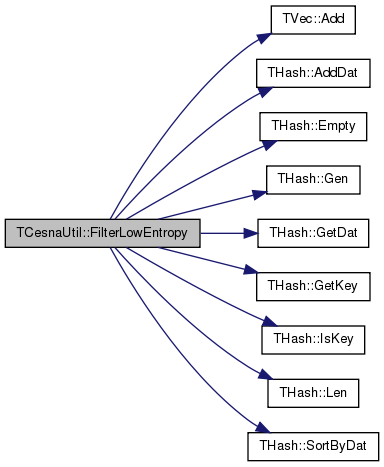

| static void TCesnaUtil::FilterLowEntropy | ( | const THash< TInt, TIntV > & | OldNIDAttrH, |
| THash< TInt, TIntV > & | NewNIDAttrH, | ||
| const double | MinFrac = 0.00001, |
||
| const double | MaxFrac = 0.95, |
||
| const int | MinCnt = 3 |
||
| ) | [inline, static] |
Definition at line 238 of file agmattr.h.
References FilterLowEntropy().
{
TIntStrH TmpH1, TmpH2;
FilterLowEntropy(OldNIDAttrH, NewNIDAttrH, TmpH1, TmpH2, MinFrac, MaxFrac, MinCnt);
}
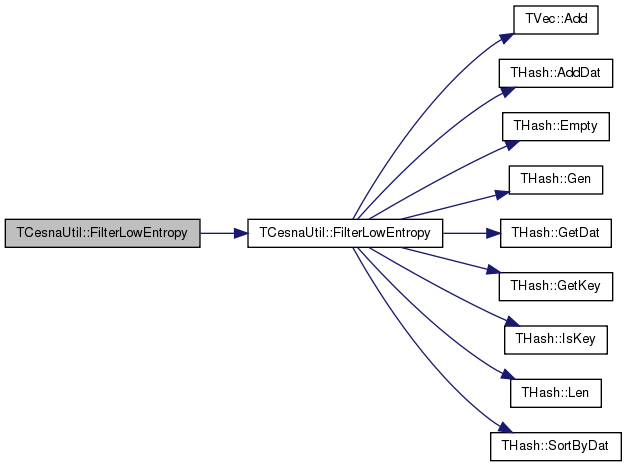
| static void TCesnaUtil::GenHoldOutPairs | ( | const PGraph & | G, |
| TVec< TIntSet > & | HoldOutSet, | ||
| double | HOFrac, | ||
| TRnd & | Rnd | ||
| ) | [inline, static] |
Definition at line 38 of file agmattr.h.
References TVec< TVal, TSizeTy >::Add(), TVec< TVal, TSizeTy >::Gen(), TRnd::GetUniDevInt(), gfDirected, HasGraphFlag, and TMath::Round().
Referenced by TCesna::FindComs(), and TCesna::SetHoldOut().
{
TIntPrV EdgeV(G->GetEdges(), 0);
for (typename PGraph::TObj::TEdgeI EI = G->BegEI(); EI < G->EndEI(); EI++) {
EdgeV.Add(TIntPr(EI.GetSrcNId(), EI.GetDstNId()));
}
EdgeV.Shuffle(Rnd);
const bool GraphType = HasGraphFlag(typename PGraph::TObj, gfDirected);
HoldOutSet.Gen(G->GetNodes());
int HOTotal = int(HOFrac * G->GetNodes() * (G->GetNodes() - 1) / 2.0);
if (GraphType) { HOTotal *= 2;}
int HOCnt = 0;
int HOEdges = (int) TMath::Round(HOFrac * G->GetEdges());
printf("holding out %d edges...\n", HOEdges);
for (int he = 0; he < (int) HOEdges; he++) {
HoldOutSet[EdgeV[he].Val1].AddKey(EdgeV[he].Val2);
if (! GraphType) { HoldOutSet[EdgeV[he].Val2].AddKey(EdgeV[he].Val1); }
HOCnt++;
}
printf("%d Edges hold out\n", HOCnt);
while(HOCnt++ < HOTotal) {
int SrcNID = Rnd.GetUniDevInt(G->GetNodes());
int DstNID = Rnd.GetUniDevInt(G->GetNodes());
if (SrcNID == DstNID) { continue; }
HoldOutSet[SrcNID].AddKey(DstNID);
if (! GraphType) { HoldOutSet[DstNID].AddKey(SrcNID); }
}
}
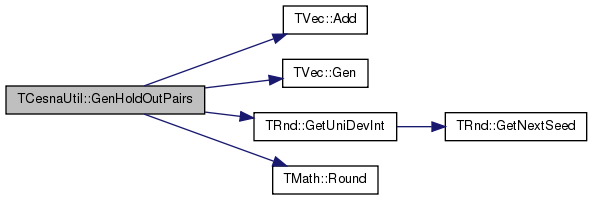

| static int TCesnaUtil::GetAttrs | ( | const THash< TInt, TIntV > & | NIDAttrH | ) | [inline, static] |
Definition at line 166 of file agmattr.h.
References THash< TKey, TDat, THashFunc >::Len().
{
int Attrs = 0;
for (int u = 0; u < NIDAttrH.Len(); u++) {
for (int k = 0; k < NIDAttrH[u].Len(); k++) {
if (NIDAttrH[u][k] >= Attrs) { Attrs = NIDAttrH[u][k] + 1; }
}
}
return Attrs;
}

| static double TCesnaUtil::GetConductance | ( | const PGraph & | Graph, |
| const TIntSet & | CmtyS, | ||
| const int | Edges | ||
| ) | [inline, static] |
Definition at line 10 of file agmattr.h.
References gfDirected, HasGraphFlag, THashSet< TKey, THashFunc >::IsKey(), and THashSet< TKey, THashFunc >::Len().
Referenced by GetNIdPhiV().
{
const bool GraphType = HasGraphFlag(typename PGraph::TObj, gfDirected);
int Edges2;
if (GraphType) { Edges2 = Edges >= 0 ? Edges : Graph->GetEdges(); }
else { Edges2 = Edges >= 0 ? 2 * Edges : Graph->GetEdges(); }
int Vol = 0, Cut = 0;
double Phi = 0.0;
for (int i = 0; i < CmtyS.Len(); i++) {
if (! Graph->IsNode(CmtyS[i])) { continue; }
typename PGraph::TObj::TNodeI NI = Graph->GetNI(CmtyS[i]);
for (int e = 0; e < NI.GetOutDeg(); e++) {
if (! CmtyS.IsKey(NI.GetOutNId(e))) { Cut += 1; }
}
Vol += NI.GetOutDeg();
}
// get conductance
if (Vol != Edges2) {
if (2 * Vol > Edges2) { Phi = Cut / double (Edges2 - Vol); }
else if (Vol == 0) { Phi = 0.0; }
else { Phi = Cut / double(Vol); }
} else {
if (Vol == Edges2) { Phi = 1.0; }
}
return Phi;
}


| static void TCesnaUtil::GetNbhCom | ( | const PGraph & | Graph, |
| const int | NID, | ||
| TIntSet & | NBCmtyS | ||
| ) | [inline, static] |
Definition at line 68 of file agmattr.h.
References THashSet< TKey, THashFunc >::AddKey(), and THashSet< TKey, THashFunc >::Gen().
{
typename PGraph::TObj::TNodeI NI = Graph->GetNI(NID);
NBCmtyS.Gen(NI.GetDeg());
NBCmtyS.AddKey(NID);
for (int e = 0; e < NI.GetDeg(); e++) {
NBCmtyS.AddKey(NI.GetNbrNId(e));
}
}

| static void TCesnaUtil::GetNIdPhiV | ( | const PGraph & | G, |
| TFltIntPrV & | NIdPhiV | ||
| ) | [inline, static] |
Definition at line 77 of file agmattr.h.
References TVec< TVal, TSizeTy >::Add(), TVec< TVal, TSizeTy >::Gen(), GetConductance(), and TExeTm::GetTmStr().
{
NIdPhiV.Gen(G->GetNodes(), 0);
const int Edges = G->GetEdges();
TExeTm RunTm;
//compute conductance of neighborhood community
for (typename PGraph::TObj::TNodeI NI = G->BegNI(); NI < G->EndNI(); NI++) {
TIntSet NBCmty(NI.GetDeg() + 1);
double Phi;
if (NI.GetDeg() < 5) { //do not include nodes with too few degree
Phi = 1.0;
} else {
TCesnaUtil::GetNbhCom<PGraph>(G, NI.GetId(), NBCmty);
//if (NBCmty.Len() != NI.GetDeg() + 1) { printf("NbCom:%d, Deg:%d\n", NBCmty.Len(), NI.GetDeg()); }
//IAssert(NBCmty.Len() == NI.GetDeg() + 1);
Phi = TCesnaUtil::GetConductance(G, NBCmty, Edges);
}
//NCPhiH.AddDat(u, Phi);
NIdPhiV.Add(TFltIntPr(Phi, NI.GetId()));
}
printf("conductance computation completed [%s]\n", RunTm.GetTmStr());
fflush(stdout);
}
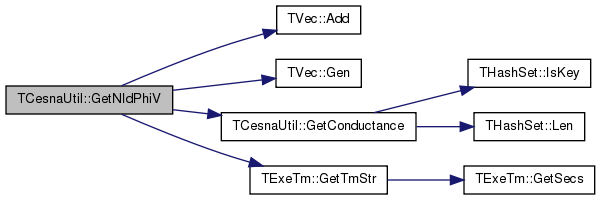
| static void TCesnaUtil::LoadNIDAttrHFromNIDKH | ( | const TIntV & | NIDV, |
| const TStr & | InFNm, | ||
| THash< TInt, TIntV > & | NIDAttrH, | ||
| const TStrHash< TInt > & | NodeNameH, | ||
| const TSsFmt | Sep = ssfTabSep |
||
| ) | [inline, static] |
Definition at line 100 of file agmattr.h.
References TVec< TVal, TSizeTy >::Add(), THash< TKey, TDat, THashFunc >::AddDat(), THash< TKey, TDat, THashFunc >::Clr(), TStr::CStr(), TStr::Fmt(), THash< TKey, TDat, THashFunc >::Gen(), TVec< TVal, TSizeTy >::Gen(), THash< TKey, TDat, THashFunc >::GetDat(), TSsParser::GetFld(), TSsParser::GetInt(), TStr::GetInt(), TStrHash< TDat, TStringPool, THashFunc >::GetKeyId(), TSsParser::GetLineNo(), TUInt64::GetStr(), IAssertR, TVec< TVal, TSizeTy >::IsIn(), THash< TKey, TDat, THashFunc >::IsKey(), TStrHash< TDat, TStringPool, THashFunc >::IsKey(), THash< TKey, TDat, THashFunc >::Len(), TVec< TVal, TSizeTy >::Len(), TStrHash< TDat, TStringPool, THashFunc >::Len(), TSsParser::Next(), ssfTabSep, and TInt::Val.
Referenced by LoadNIDAttrHFromNIDKH().
{
NIDAttrH.Clr();
NIDAttrH.Gen(NIDV.Len());
for (int u = 0; u < NIDV.Len(); u++) { NIDAttrH.AddDat(NIDV[u]).Gen(0, 0); }
TSsParser Ss(InFNm, ssfTabSep);
while (Ss.Next()) {
TStr NodeName = Ss.GetFld(0);
TInt NID = NodeName.GetInt();
if (NodeNameH.Len() > 0 && ! NodeNameH.IsKey(NodeName)) { continue; }
if (NodeNameH.Len() > 0) {
IAssertR(NodeNameH.IsKey(NodeName), TStr::Fmt("NodeName:%s", NodeName.CStr()));
NID = NodeNameH.GetKeyId(NodeName);
}
if (! NIDAttrH.IsKey(NID)) { continue; } //ignore nodes who are not in the graph
IAssertR(! NIDAttrH.GetDat(NID).IsIn(Ss.GetInt(1)), TStr::Fmt("NIdx:%d NID:%s, K:%d", NID.Val, NodeName.CStr(), Ss.GetInt(1)));
NIDAttrH.GetDat(NID).Add(Ss.GetInt(1));
}
printf("%s nodes, %s lines read \n", TUInt64::GetStr(NIDAttrH.Len()).CStr(), TUInt64::GetStr(Ss.GetLineNo()).CStr());
//printf("%d nodes, %d lines read \n", NIDAttrH.Len(), Ss.GetLineNo());
}
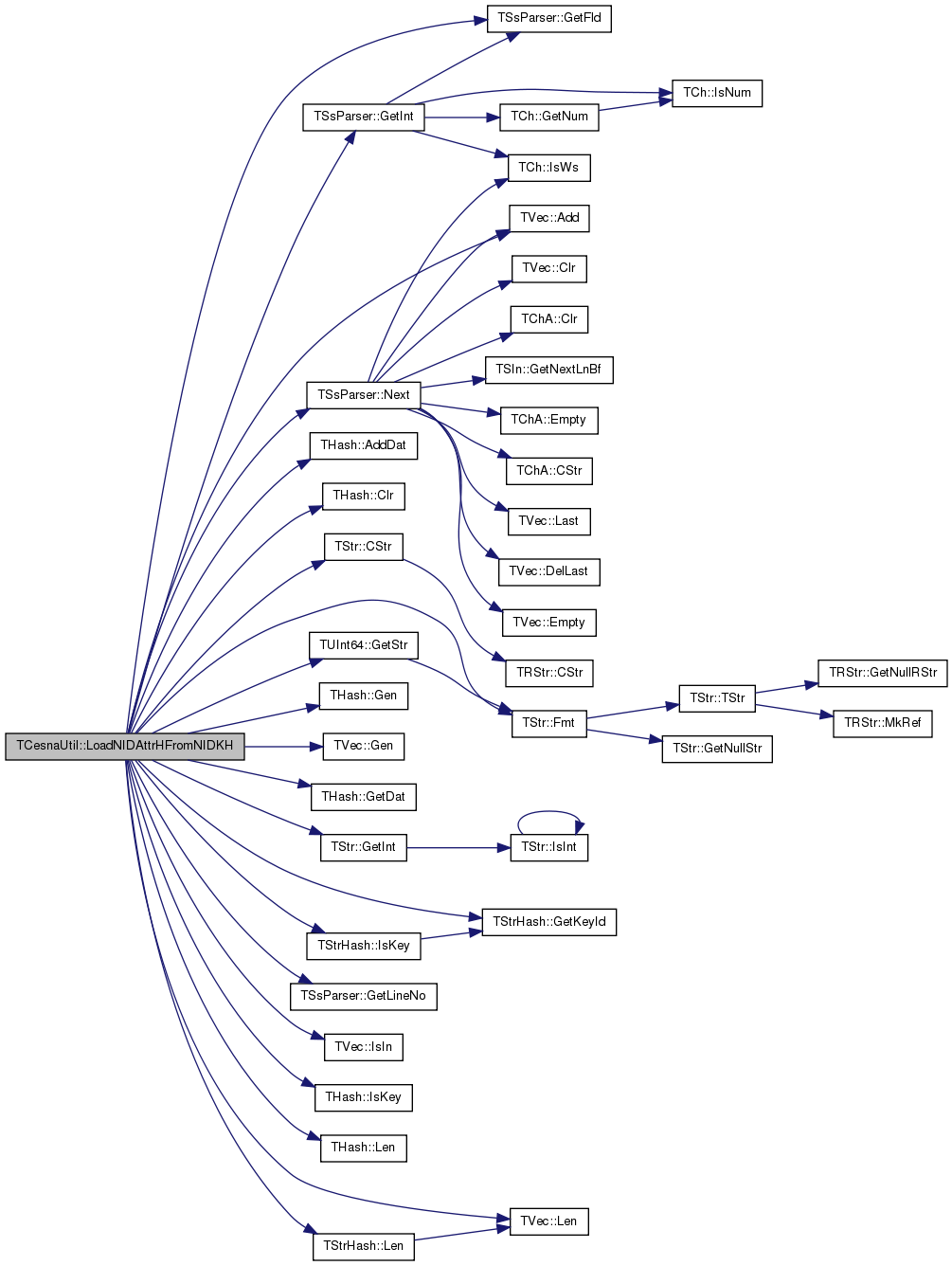

| static void TCesnaUtil::LoadNIDAttrHFromNIDKH | ( | const TIntV & | NIDV, |
| const TStr & | InFNm, | ||
| THash< TInt, TIntV > & | NIDAttrH | ||
| ) | [inline, static] |
Definition at line 120 of file agmattr.h.
References LoadNIDAttrHFromNIDKH().
{
TStrHash<TInt> TmpH;
LoadNIDAttrHFromNIDKH(NIDV, InFNm, NIDAttrH, TmpH);
}
